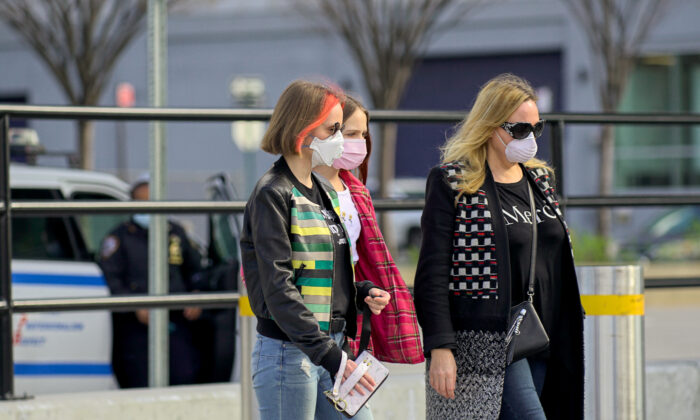By Zachary Stieber
Cloth masks are of little use against COVID-19, according to a recently published analysis.
Federal health authorities and a slew of jurisdictions require or recommend wearing masks as a way to limit spread of the virus that causes COVID-19.
But a trio of researchers pored over the studies often cited by the officials and found they were poorly designed and offered scant evidence supporting mask usage.
Many of the studies are observational, opening them up to confounding variables, the researchers said in their analysis (pdf), which was published on Nov. 8 by the Cato Institute.
Of 16 randomized controlled trials comparing mask effectiveness to controls with no masks, 14 failed to find a statistically significant benefit, the researchers said. And of 16 quantitative meta-analyses, half showed weak evidence of mask effectiveness while the others “were equivocal or critical as to whether evidence supports a public recommendation of masks,” they added.
“The biggest takeaway is that more than 100 years of attempts to prove that masks are beneficial has produced a large volume of mostly low-quality evidence that has generally failed to demonstrate their value in most settings,” Dr. Jonathan Darrow, an assistant professor of medicine at Harvard Medical School, told The Epoch Times in an email.
“Officials mulling mask recommendations should turn their attention to interventions with larger and more certain benefits, such as vaccines. Based on the evidence currently available, masks are mostly a distraction from the important work of promoting the public health,” he added.
One widely-cited study (pdf) by mask proponents, of rural villages in Bangladesh, found that surgical masks appeared to be marginally effective in reducing symptomatic COVID-19 but that cloth masks did not, Darrow and his colleagues noted. The other real-world randomized controlled trial examining mask effectiveness, conducted in Denmark, did not find a statistically significant difference in infections between the masked and unmasked groups.
“The remainder of the available clinical evidence is primarily limited to non-randomized observational data, which are subject to confounding,” the researchers said, including accounting for other differences in behavior among those who don’t wear masks.
They did say that there is evidence masks reduce droplet dispersion, though cloth masks are unlikely to capture the particles even if worn properly.
Due to the COVID-19 pandemic, policymakers cannot wait for higher-quality evidence to support masking, but from an ethical standpoint, they should “refrain from portraying the evidence as stronger than it actually is,” the researchers concluded.
COVID-19 is the disease caused by the CCP (Chinese Communist Party) virus. The CCP virus is also known as the coronavirus, or SARS-CoV-2.
Some outside experts’ views align with the researchers, including Dr. Martin Kulldorff, senior scientific director of the Brownstone Institute.
“The truth is that there has been only two randomized trials of masks for COVID. One was in Denmark, which showed that they might be slightly beneficial, they might be slightly harmful, we don’t really know—the confidence interval kind of crossed zero,” he said. “And then there was another study from Bangladesh where they randomized villagers to masks or no masks. And the efficacy of the masks was for reduction of COVID was something between zero and 18 percent. So either no effect or very minuscule effect.”
Some experts, though, say the existing evidence does support masking recommendations, and several reacted strongly to the new analysis.
The analysis drew some pushback, including from Kimberly Prather, director of the National Science Foundation Center for Aerosol Impacts on Chemistry of the Environment.
Prather noted on Twitter that researchers said masks reduce the amount of virus in the air and believed that ran counter to their conclusions.
Read More From The PatriotAmerican
Darrow responded by saying the amount of virus in the air was a surrogate, not a clinical endpoint.
“The amount of pathogen in air (to be inhaled) directly determines the dose. This is directly linked to risk,” Prather added. “Or can you explain how less virus in the air could be higher risk? It’s equivalent to saying that less pathogen in drinking water is higher risk so don’t filter water.”
“If the theory diverges from what you see in real life, which one do you believe?” Darrow said.


OSHA requires us to wear a N95 mask in a dusty environment. With a virus many times smaller than a dust particle no way a cloth mask would be affective. This is something the government is pushing to make the population feel good.